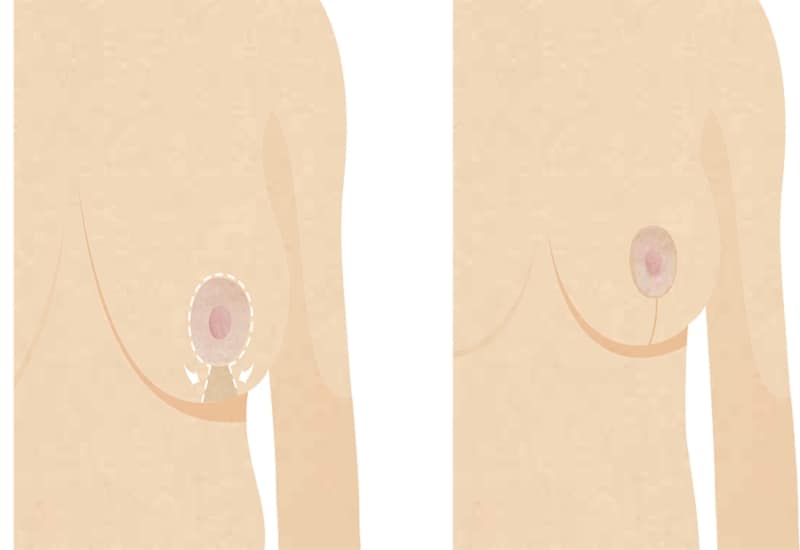Breast Reduction
Breast Reduction in Surrey, BC
For women with excessively large heavy breasts, breast reduction surgery can dramatically change the way they feel and look. The surgery, which involves removing excess breast tissue through a small incision, alleviates the physical discomfort and inconvenience of large breasts, and gives a better-proportioned body. For many women, breast reduction surgery results in them feeling more comfortable and confident about their bodies. Breast reduction may be a medically insured procedure for women who have medical problems due to the size of their breasts and who meet the requirements set by MSP.
Our Vancouver & Fraser Valley service areas include Surrey, Langley, Abbotsford, Chilliwack, Coquitlam, Port Moody, Port Coquitlam, Pitt Meadows and Mission, BC.
Am I a Good Candidate for Breast Reduction Surgery?
In most cases, breast reduction isn’t performed until a woman’s breasts are fully developed. However, it can be done earlier if large breasts are causing serious physical discomfort. You must be emotionally mature, understand your motivations for having this procedure, and have realistic expectations about what the surgery can achieve. It’s important that you are not at smoker as the risks of serious complications, including nipple loss and breathing problems around the time of the surgery, would become much higher.
Breast reduction surgery may be helpful if you:
- Have breasts that are too large in proportion to the rest of your body
- Suffer from skin irritation and rashes under your breasts
- Get back, neck, and shoulder pain from the weight of your breasts,
- Have one breast that is significantly larger than the other
- Have indentations in your shoulder from your bra
- Can’t exercise due to breast size
- Can’t fit into clothes due to the size of your breasts

Your First Visit
During your initial consultation with The Plastic Surgery Group, your plastic surgeon will do a physical examination and go over your concerns and expectations. As every patient is an individual — your age, the size and shape of your breasts, and the condition of your skin can all impact the procedure chosen and the final result — your plastic surgeon will discuss the procedure that best fits your goals and body. At this time, you will be given a basic understanding of the procedure, including how it can help, how it’s performed, what results you can expect, and its risks and limitations
Breast Reduction Surgery
A breast reduction is performed under general anesthesia, which means you will be asleep through the entire operation. The surgery is approximately 1-2 hours and you will spend approximately 3 hours in the recovery room, so plan to spend the whole day at the hospital. You will be given a prescription for pain-killers and possibly antibiotics. There are a few variations in breast reduction technique but they all have three common components:
- Removing breast tissue and fat to reduce size
- Repositioning and making the nipple-areola area smaller and in a more youthful position on the breast mound
- Removing and redraping extra skin to lift and reshape the breast
The techniques differ in where the excess breast tissue and skin are removed from, where the mound under the nipple is situated, and what the scars will look like.
The Most Common Procedures
No Vertical Scar
No vertical scar breast reduction leaves a scar that extends around the areola and under the crease of the breast. The exact choice of breast reduction depends on many factors, such as the size of breasts, skin quality, and amount of breast sag. Scars are permanent but can be easily concealed by clothing and even a bathing suit. In most cases, the nipples remain attached to their blood vessels and nerves through a pedicle or mound of breast tissue. However, in rare cases, if the breasts are very large or pendulous, the nipple and areola may have to be completely removed and grafted onto a higher position (this will result in a loss of sensation in the nipple and areolar tissue). Breast reduction surgery does not remove fat on the sides of the chest under the armpit, although some patients who have a significant role in this area have it flattened with liposuction. Liposuction will lessen the bulk in this area, although this adds to the breast reduction is not covered by insurance.
Wise Pattern
Wise pattern breast reduction leaves an anchor-shaped scar that circles the areola, extends straight downward, and then follows the natural curve of the crease beneath the breast. It is often used for women who have excessively large breasts or women with breasts that sag a lot and need a lot of skin removed to lift them.
Short Scar
Short scar or vertical breast reduction leaves a lollipop scar that extends around the areola and down the lower part of the breast.
Preparing for Surgery
Your mammograms should be up-to-date because results may be skewed for any mammogram taken during the first 6-12 months after surgery. It is best to be at a body weight that you want to maintain after your breast reduction. The operative result is more predictable with a stable weight and the operative risks are less in patients who are not significantly overweight. You should not smoke for at least 4 weeks before surgery and 2 weeks after and you should stop taking all over-the-counter pain or fever medicines (except Tylenol) and blood thinners for two weeks prior to your procedure. Many herbal medicines can also cause bleeding and so need to be stopped before surgery, including ginkgo biloba, St. John’s Wort, and high doses of fish oil, flax seed oil, or vitamin E.
Possible Complications
Breast reduction is not a simple operation but it’s safe when performed by a qualified plastic surgeon. The more common complications are still infrequent and often go away on their own or with minimal treatment. Issues specific to this surgery include, but are not limited to, asymmetry, numb skin/nipples, and scar tissue around the incision. Your surgeon will discuss all potential complications at the time of consultation.
Breast Reduction Recovery
You will need someone to drive you home after surgery and you may need some help for the next few days. Following breast reduction surgery, most women are up and about the next day, but the breasts may ache occasionally for a couple of weeks. You should avoid lifting or pushing anything heavy for two weeks and avoid pools or hot tubs for 3 weeks. You can typically return to regular activity within a couple of weeks of surgery and feel normal after a month or so.
Although much of the swelling and bruising will disappear in the first few weeks, it may be six months to a year before your breasts settle into their new shape. Even then, their shape may fluctuate in response to your hormonal shifts, weight changes, and pregnancy. Your surgeon will make every effort to make your scars as inconspicuous as possible. Still, it’s important to remember that breast reduction scars are extensive and permanent. They often remain lumpy and red for months, and then gradually become less obvious, sometimes eventually fading to thin white lines. Fortunately, the scars can usually be placed so that you can wear even low-cut tops.
Frequently Asked Questions About Breast Reduction
Are there age requirements for breast reduction candidates?
There are no age requirements for breast reduction. In younger candidates, our plastic surgeons advise waiting until breast development is complete. Operating on breasts that are still growing can be risky.
Can I choose how much my breasts are reduced?
Yes, you will have the opportunity to discuss your desired breast size with your plastic surgeon prior to surgery. Good patient-surgeon communication is key to achieving a size that aligns with your goals and looks proportional to your physique.
Will I have scarring after breast reduction?
Yes. Scarring is unavoidable due to the surgical incisions. However, the scars can be hidden underneath a bra or bathing suit top. Also, the amount and location of scarring depends on the specific incision pattern used, and your genetic tendency to scarring (some people tend to have thicker scars). There are many different ways to perform breast reduction, and whenever possible, our surgeons use incisions that follow the natural lines of the breast. Although we can recommend techniques to minimize scarring, we cannot change your genetics or make scars disappear completely. However, keep in mind that our patients often tell us they are happy to trade some scarring for lighter, more proportional breasts.
Can I breastfeed after breast reduction?
With today’s surgical techniques, it is possible to breastfeed after breast reduction — but not guaranteed. If you hope to breastfeed, please let your surgeon know during the planning process so he or she can discuss your treatment options.
Will my breasts look perkier after breast reduction?
Yes, breast reduction involves lifting the remaining breast tissue and reshaping it higher on the chest wall. Your breasts should look perkier and more youthful after surgery.
Will my nipples change from breast reduction?
Breast reduction can reduce the diameter of your nipple-areolar complex if you wish. There is a small chance that you could lose nipple sensation. Our surgeons can discuss this risk with you in more detail during your consultation and explain what we do to prevent it.
How quickly will I see results after breast reduction?
Your breasts should look smaller and firmer almost immediately after surgery. However, you will have bruising and swelling concealing your results. It can take up to a few months for the aftereffects to subside and your improved breast shape to stabilize.
When will I feel like myself again after surgery?
Every patient recovers differently, and it can take time to look and feel “normal” again. Most patients tell us it can take several months.
Will I need to wear a special bra after surgery?
Yes. We encourage you to wear a special compression bra immediately after surgery to help minimize swelling. When you switch back to regular bras, we recommend you initially avoid wearing bras with underwire, as the wire can irritate your incisions. Sports bras are usually the most comfortable style to wear.
Are my results permanent?
Your breasts can enlarge later in life if you become pregnant and nurse, or gain a significant amount of weight. If your breasts become oversized or heavy again, you can look into having a second breast reduction surgery.


